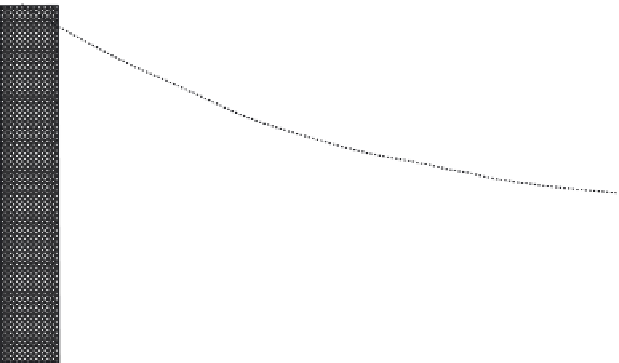Environmental Engineering Reference
In-Depth Information
concentration is dilution, and transport in the subsoil will likely be consistent with the
advective velocity of the groundwater. Except for physical controls on groundwater low,
no other soil properties are involved in the dilution process.
Retention
refers to the retention of contaminants by the soil solids through partitioning
processes that involve physicochemical and chemical mass transfer. The result of reten-
tion is a decrease in the concentration of contaminants in a leachate plume or liquid waste
stream as one progress away from the source. Using the same numerical example as above,
one would see a reduction from 100 ppm to 50 ppm in a contaminant transport stream at
a point further downstream from the contaminant source. The difference between this
and the previous example is that when reduction of concentration is obtained through
retention processes, the contaminants retained will not be readily available for transport.
In the case of dilution as a means for reduction in concentration of contaminants, there
are no contaminants held by the soil particles. All the contaminants will be delivered
downstream in due time. Figure 10.11 illustrates the differences using assumed ideal bell-
shaped concentration distribution pulses. In the case of dilution, the diagram shows that
eventually, the total contaminant load will be delivered downstream. The areas of the
assumed bell-shaped dilution pulses are all constant and equal to the original rectangular
distribution shown on the ordinate. In contrast, the assumed bell-shaped retention pulses
will show decreasing areas. These retention pulses will diminish to zero so long as the
assimilative capacity of the soil is not exceeded. This is a signiicant point of consider-
ation in the use of the natural attention capacity of soils for mitigation and management of
impacts from liquid waste and contaminant discharges.
Contaminant pulse load
(area defines total contaminant load)
Dilution pulse
Advective and diffusive
movement of
contaminants
Retention pulse
Source
Distance from source
FIGURE 10.11
Illustration of difference between retardation and retention of contaminants during transport of a contaminant
pulse load. Note that the areas of the assumed bell-shaped dilution pulses are constant and that they are equal
to the original contaminant pulse load. The areas of the assumed bell-shaped retention pulses diminish as one
progresses further away from the source.






















Search WWH ::

Custom Search